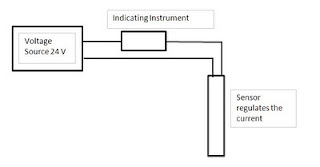The 4 - 20 mA signal is an extremely popular signal specification in instruments. The 4 to 20 mA signal provides "live zero" function. i.e. in the event of a wire break, the signal drops to zero mA. This can be used to detect wire break or sensor failure. This is a crucial advantage of the 4 to 20 mA format.
Being a Current signal, it is also less susceptible to external interference.

The 4 to 20 mA format works by varying the resistance to a constant source voltage. The sensor consists of a transistor which regulates the current passing through it in accordance with the measured value. Sensors which use this format can be categorized into active and passive transducers. Active transducers are devices which can provide the system voltage as well as regulate the current. Passive devices require an external voltage and only regulate the current.
Another advantage of this 4 to 20 mA format is that it can be easily converted into a voltage signal by means of a resistor. (1 - 5 volts for a 250 ohm resistor).
Being a Current signal, it is also less susceptible to external interference.

The 4 to 20 mA format works by varying the resistance to a constant source voltage. The sensor consists of a transistor which regulates the current passing through it in accordance with the measured value. Sensors which use this format can be categorized into active and passive transducers. Active transducers are devices which can provide the system voltage as well as regulate the current. Passive devices require an external voltage and only regulate the current.
Another advantage of this 4 to 20 mA format is that it can be easily converted into a voltage signal by means of a resistor. (1 - 5 volts for a 250 ohm resistor).











No comments:
Post a Comment